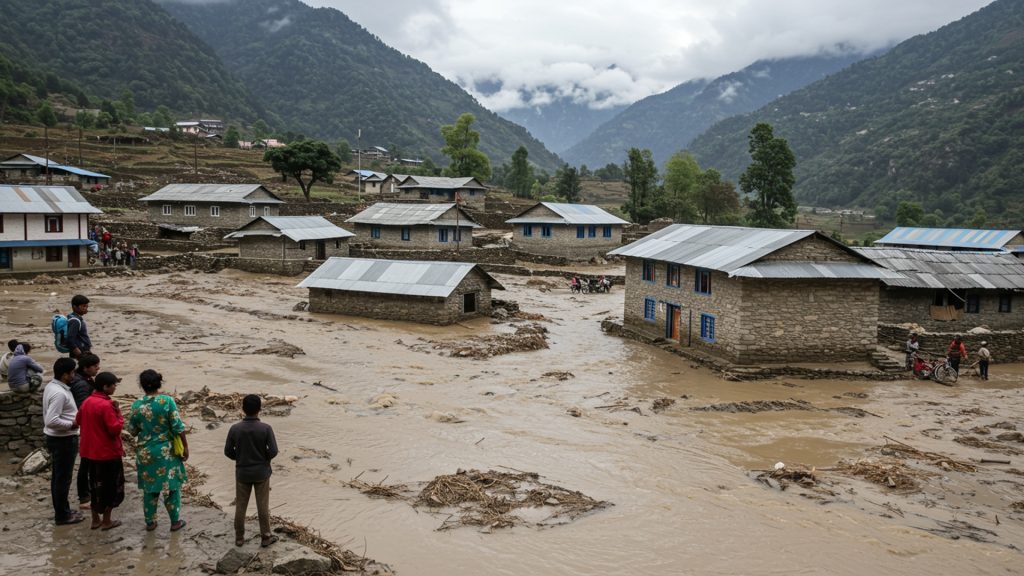Relentless monsoon rains tear through Uttarakhand, India, displacing thousands of people as entire villages vanish under the fury of landslides and flash floods. Overflowing rivers and unstable hillsides swallow homes, farms. livelihoods right now, leaving countless families stranded and without shelter. This ongoing natural disaster turns once-thriving communities into desolate landscapes, as emergency teams struggle to reach isolated areas and provide urgent aid to those who have lost everything.
Monsoon Fury Sweeps Away Villages, Displacing Thousands in Uttarakhand
Widespread Rain Causes Huge Destruction
Heavy and continuous monsoon rains have caused much damage across Uttarakhand, leading to many people having to leave their homes. The state has seen a large number of landslides, floods. cloudbursts. In the past 14 years, 245 villages have been badly affected, meaning about 17 villages are lost each year, forcing thousands of families to leave their old homes. This year’s monsoon has brought fresh trouble, with key areas seeing extreme weather. Towns like Dehradun, Haridwar. Nainital have faced heavy water on the streets, making it hard for people to move. Many houses have been flooded and damaged, making families leave. Hilly areas, such as Mussoorie and Chamoli, have been hit hard by landslides. These landslides have blocked roads, cut off villages. even caused deaths. In the current monsoon season, 65% of days, specifically 43 out of 66 days between June 1 and August 5, had extreme weather events. This is the highest number in four years, more than 59% in 2024, 47% in 2023. 33% in 2022. Since June 1, weather-related events have taken 39 lives, with 13 people still missing. This number does not include the 43 people still not found in Dharali.
Villages Disappear Under Mud and Water
Some villages have almost disappeared due to the extreme weather. On August 5, 2025, the village of Dharali in Uttarkashi was hit by a huge amount of rain that caused a landslide and floods. The village was completely flattened. Only one body has been found so far. 69 people are still missing, including nine army personnel and 25 workers from Nepal. The strong flow of water, mud. rocks hit Dharali with such force that buildings were torn from their foundations. homes were buried up to their roofs in moments. The incident badly affected other villages too, such as Sukhi, Jaspur, Purali, Jhala, Harshil, Bagori. Kukhwa, with widespread damage to homes, roads. farm areas. Travel across the region has been severely affected because roads and bridges have been washed away. An artificial lake was formed that covered large areas of land, including an entire village and a government helipad. The continuing rains are making rescue work difficult. Landslides and roads being washed away are reported daily from many places since August 5. A bridge between Dharali and Mukhba, another nearby village, has been declared unsafe by the Army. People now have to walk 12-15 kilometers to reach Dharali by road because a big part of the road that connects Gangnani village to Dharali was washed away by a landslide.
Help and Rescue Efforts Are Underway
Many teams, including the Army, National Disaster Response Force (NDRF), State Disaster Response Force (SDRF). Indo-Tibetan Border Police (ITBP), are working day and night to help those affected and bring back vital services. So far, more than a thousand people have been rescued. As of August 9, 2025, 816 people have been rescued by these joint efforts. Essential relief items are being dropped by helicopters in the areas hit by the disaster. Road access has been opened up to Limchigad. a 90-foot Bailey Bridge is being built to help connect areas.
Government Steps in to Help
The state government has taken steps to help the people affected by the disaster. The government has approved 20 crore rupees from the State Disaster Response Fund to help with rescue and relief work in Uttarkashi. The Chief Minister has announced that families whose houses have been completely destroyed in Dharali village will get 5 lakh rupees as immediate help for their new homes. Also, families of those who died in the disaster will get 5 lakh rupees each as financial support. A three-member committee has been set up for the full rehabilitation, recovery. long-term support of the villagers affected by the disaster. This committee, led by the Revenue Secretary, will give its first report to the government within a week. The state government has completed the process of rehabilitation and displacement for 2,629 affected families so far. More than 111 crore rupees have already been spent on moving and rehabilitating affected families. For the current financial year (2025-26), 20 crore rupees were set aside for the rehabilitation and relocation of villages hit by disasters. As of now, 11. 44 crore rupees have been released, helping 255 families in 12 villages.
Looking at the Challenges Ahead
The monsoon’s impact is not just a past event; it is a problem that is still happening. Experts say that without quick actions, similar disasters are likely to happen more often and be more deadly in the future. The region’s difficult land and weather already make it open to heavy rainfall and landslides. Rising temperatures are changing monsoon patterns and making events more severe. Human activities, like cutting down trees, unplanned building. melting glaciers, are making the risks worse. Rivers fed by melting glaciers and heavy rain are more likely to cause flash floods. Farming, which is a main source of income for many in Uttarakhand, has been badly hit by the heavy rains. Farmers in both flat and hilly areas have seen their crops washed away or damaged by too much water. The good soil has been washed away in many places, which will affect future crops. This impacts not only the food supply but also the money stability of farming families. It is very vital to have a strong system for watching, giving early warnings. alerting people about possible disaster risks in the region. This will make sure that people in dangerous areas are quickly told through reliable and scientific forecasts from the right government bodies.

